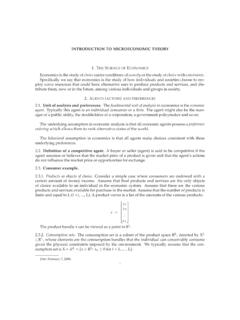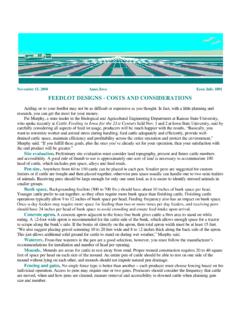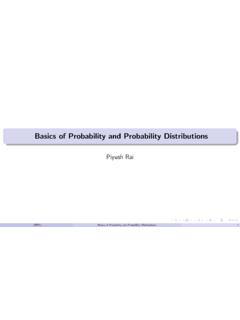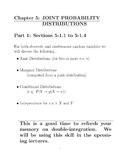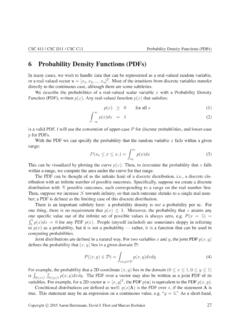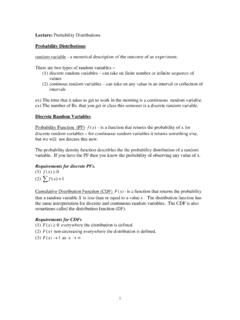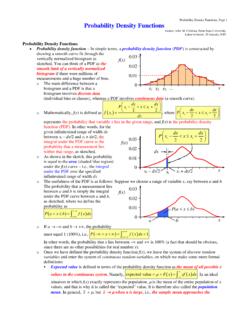Transcription of RANDOM VARIABLES AND PROBABILITY DISTRIBUTIONS
1 RANDOM VARIABLES AND PROBABILITY DISTRIBUTIONS1. DISCRETE RANDOM of a Discrete RANDOM RANDOM variable X is said to bediscreteif it canassume only a finite or countable infinite number of distinct values. A discrete RANDOM variablecan be defined on both a countable or uncountable sample for a discrete RANDOM PROBABILITY that X takes on the value x, P(X=x),is defined as the sum of the probabilities of all sample points in that are assigned the value x. Wemay denote P(X=x) by p(x) or pX(x). The expression pX(x) is a function that assigns probabilitiesto each possible value x; thus it is often called the PROBABILITY function for the RANDOM variable distribution for a discrete RANDOM PROBABILITY distribution for adiscrete RANDOM variable X can be represented by a formula, a table, or a graph, which providespX(x) = P(X=x) for all x.
2 The PROBABILITY distribution for a discrete RANDOM variable assigns nonzeroprobabilities to only a countable number of distinct x values. Any value x not explicitly assigned apositive PROBABILITY is understood to be such that P(X=x) = function pX(x)= P(X=x) for each x within the range of X is called theprobability distributionof X. It is often called the PROBABILITY mass function for the discrete RANDOM variable of the PROBABILITY distribution for a discrete RANDOM function canserve as the PROBABILITY distribution for a discrete RANDOM variable X if and only if it s values,pX(x), satisfy the conditions:a:pX(x) 0 for each value within its domainb: xpX(x)=1,where the summation extends over all the values within its of PROBABILITY mass a formula for the PROBABILITY distribution of the total number of heads ob-tained in four tosses of a balanced sample space, probabilities and the value of the RANDOM variable are given in table the table we can determine the probabilities asP(X=0) =116,P(X=1) =416,P(X=2) =616,P(X=3) =416,P(X=4) =116(1)Notice that the denominators of the five fractions are the same and the numerators of the fivefractions are 1, 4, 6, 4, 1.
3 The numbers in the numerators is a set of binomial (40)116,416=(41)116,616=(42)116,416=(43) 116,116=(44)116We can then write the PROBABILITY mass function asDate: November 1, VARIABLES AND PROBABILITY of a Function of the Number of Heads from Tossing a CoinFour a Coin Four TimesElement of sample spaceProbabilityValue of RANDOM variable X (x)HHHH1/164 HHHT1/163 HHTH1/163 HTHH1/163 THHH1/163 HHTT1/162 HTHT1/162 HTTH1/162 THHT1/162 THTH1/162 TTHH1/162 HTTT1/161 THTT1/161 TTHT1/161 TTTH1/161 TTTT1/160pX(x)=(4x)16for x=0,1,2,3,4(2)Note that all the probabilities are positive and that they sum to a red die and a green die. Let the RANDOM variable be the larger of the twonumbers if they are different and the common value if they are the same.
4 There are 36 points inthe sample space. In table 2 the outcomes are listed along with the value of the RANDOM variableassociated with each PROBABILITY that X = 1, P(X=1) = P[(1, 1)] = 1/36. The PROBABILITY that X = 2, P(X=2) = P[(1, 2),(2,1), (2, 2)] = 3/36. Continuing we obtainP(X=1) =136,P(X=2) =336,P(X=3) =536P(X=4) =736,P(X=5) =936,P(X=6) =1136We can then write the PROBABILITY mass function aspX(x)=P(X=x)=2x 136for x=1,2,3,4,5,6 Note that all the probabilities are positive and that they sum to distribution VARIABLES AND PROBABILITY DISTRIBUTIONS3 TABLE2. Possible Outcomes of Rolling a Red Die and a Green Die First Numberin Pair is Number on Red DieGreen (A)123456 Red (D) of a Cumulative distribution X is a discrete RANDOM variable, the functiongiven byFX(x)=P(x X)= t xp(t)for x (3)where p(t) is the value of the PROBABILITY distribution of X at t, is called thecumulative distributionfunctionof X.
5 The function FX(x) is also called thedistribution functionof of a Cumulative distribution values FX(X) of the distribution functionof a discrete RANDOM variable X satisfy the conditions1:F(- ) = 0 and F( ) =1;2:If a<b, then F(a) F(b) for any real numbers a and example of a cumulative distribution tossing a coin four times. Thepossible outcomes are contained in table 1 and the values of p( ) in equation 2. From this we candetermine the cumulative distribution function as (0) = (0) =116F(1) = (0) +p(1) =116+416=516F(2) = (0) +p(1) +p(2) =116+416+616=1116F(3) = (0) +p(1) +p(2) +p(3) =116+416+616+46=1516F(4) =p(0) +p(1) +p(2) +p(3) +p(4) =116+416+616+46+116=1616We can write this in an alternative fashion as4 RANDOM VARIABLES AND PROBABILITY DISTRIBUTIONSFX(x)= 0for x <0116for0 x<1516for1 x<21116for2 x<31516for3 x<41for x example of a cumulative distribution a group of N individuals, M ofwhom are female.
6 Then N-M are male. Now pick n individuals from this population withoutreplacement. Let x be the number of females chosen. There are(Mx)ways of choosing x femalesfrom the M in the population and(N Mn x)ways of choosing n-x of the N - M males. Therefore,there are(Mx) (N Mn x)ways of choosing x females and n-x males. Because there are(Nn)ways ofchoosing n of the N elements in the set, and because we will assume that they all are equally likelythe PROBABILITY of x females in a sample of size n is given bypX(x)=P(X=x)=(Mx)(N Mn x)(Nn)for x=0,1,2,3, ,nand x M, and n x N M.(4)For this discrete distribution we compute the cumulative density by adding up the appropriateterms of the PROBABILITY mass (0) =p(0)F(1) =p(0) +p(1)F(2) =p(0) +p(1) +p(2)F(3) =p(0) +p(1) +p(2) +px(3).
7 F(n)=p(0) +p(1) +p(2) +p(3) + +p(n)(5)Consider a population with four individuals, three of whom are female, denoted respectivelyby A, B, C, D where A is a male and the others are females. Then consider drawing two from thispopulation. Based on equation 4 there should be(42)= 6 elements in the sample space. The samplespace is given Two Individuals from a Population of Four where OrderDoes Not Matter (no replacement)Element of sample spaceProbabilityValue of RANDOM variable XAB1/61AC1/61AD1/61BC1/62BD1/62CD1/62 RANDOM VARIABLES AND PROBABILITY DISTRIBUTIONS5We can see that the PROBABILITY of 2 females is12. We can also obtain this using the formula (2) =P(X=2)=(32)(10)(42)=(3)(1)6=12(6)Simila rlyp(1) =P(X=1)=(31)(11)(42)=(3)(1)6=12(7)We cannot use the formula to compute f(0) because (2 - 0)6 (4 - 3).
8 F(0) is then equal to 0. We canthen compute the cumulative distribution function asF(0) =p(0) = 0F(1) =p(0) +p(1) =12F(2) =p(0) +p(1) +p(2) = 1(8) of expected X be a discrete RANDOM variable with PROBABILITY functionpX(x). Then theexpected valueof X, E(X), is defined to beE(X)= xxpX(x)(9)if it exists. The expected value exists if x|x|pX(x)< (10)The expected value is kind of a weighted average. It is also sometimes referred to as the popu-lation mean of the RANDOM variable and denoted example computing an expected a die that has six sides. Observe the numberthat comes up. The PROBABILITY mass or frequency function is given bypX(x)=P(X=x)={16for x=1,2,3,4,5,60otherwise(11)We compute the expected value asE(X)= x XxpX(x)=6 i=1i(16)=1+2+3+4+5+66=216=312(12)6 RANDOM VARIABLES AND PROBABILITY example computing an expected a group of 12 television sets, two ofwhich have white cords and ten which have black cords.}
9 Suppose three of them are chosen at ran-dom and shipped to a care center. What are the probabilities that zero, one, or two of the sets withwhite cords are shipped? What is the expected number with white cords that will be shipped?It is clear that x of the two sets with white cords and 3-x of the ten sets with black cords can bechosen in(2x) (103 x)ways. The three sets can be chosen in(123)ways. So we have a probabilitymass function as (x)=P(X=x)=(2x)(103 x)(123)for x=0,1,2(13)For examplep(0) =P(X=0)=(20)(103 0)(123)=(1) (120)220=611(14)We collect this information as in table for Television Problemx012pX(x)6/119/221/22FX(x)6/1121/ 221We compute the expected value asE(X)= x XxpX(x)= (0)(611)+ (1)(922)+ (2)(122)=1122=12(15) value of a function of a RANDOM X be a discrete RANDOM variable with PROBABILITY mass function pX(x) and g(X) be a real-valued function of X.
10 Then the expected value of g(X) is given byE[g(X)] = xg(x)pX(x).(16)Proof for case of finite values of the case where the RANDOM variable X takes on a finitenumber of values x1,x2,x3, xn. The function g(x) may not be one-to-one (the different valuesof ximay yield the same value of g(xi). Suppose that g(X) takes on m different values (m n). Itfollows that g(X) is also a RANDOM variable with possible values g1,g2,g3,..gmand probabilitydistributionP[g(X)=gi]= xjsuch thatg(xj)=gip(xj)=p (gi)(17) RANDOM VARIABLES AND PROBABILITY DISTRIBUTIONS7for all i = 1, 2, .. m. Herep (gi)is the PROBABILITY that the experiment results in a value for thefunction f of the initial RANDOM variable ofgi. Using the definition of expected value in equationwe obtainE[g(X)] =m i=1gip (gi).)







